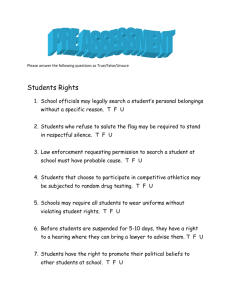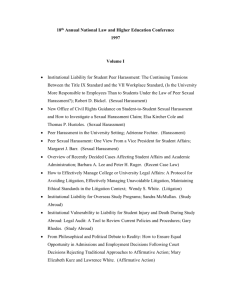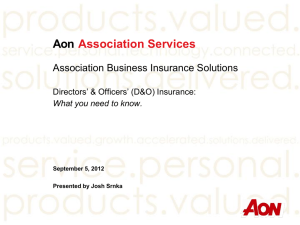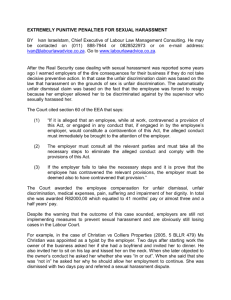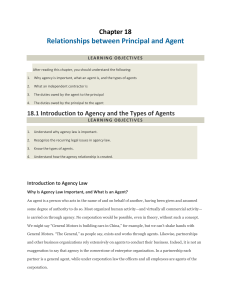BUSINESS LAW 108 - CLASS 1
advertisement
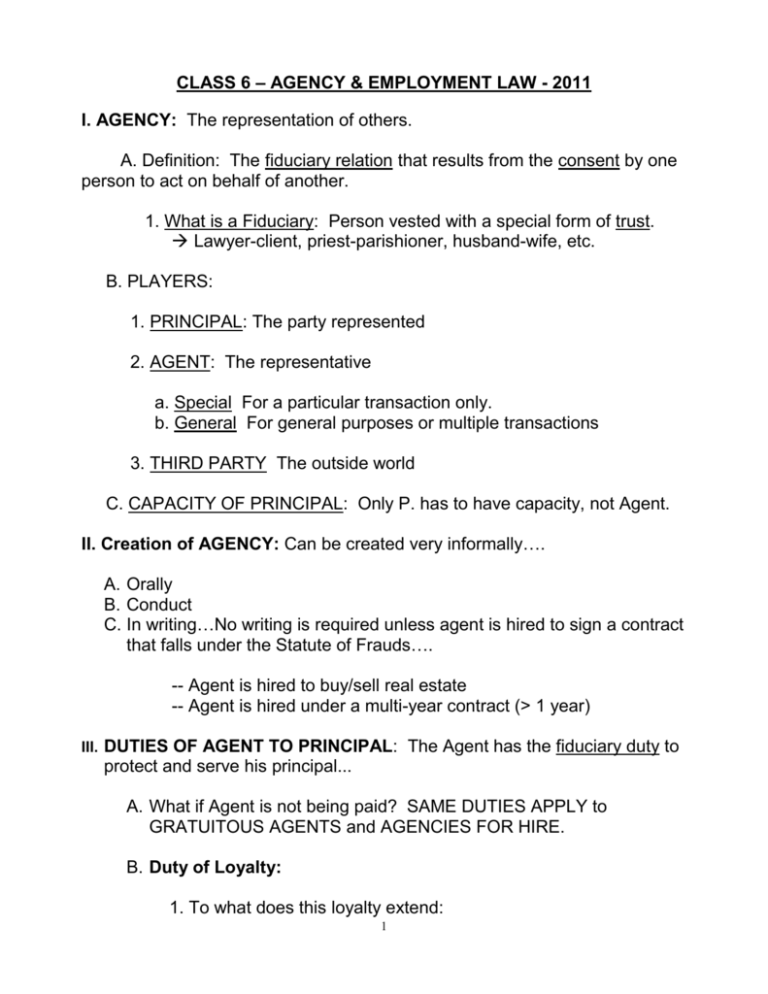
CLASS 6 – AGENCY & EMPLOYMENT LAW - 2011 I. AGENCY: The representation of others. A. Definition: The fiduciary relation that results from the consent by one person to act on behalf of another. 1. What is a Fiduciary: Person vested with a special form of trust. Lawyer-client, priest-parishioner, husband-wife, etc. B. PLAYERS: 1. PRINCIPAL: The party represented 2. AGENT: The representative a. Special For a particular transaction only. b. General For general purposes or multiple transactions 3. THIRD PARTY The outside world C. CAPACITY OF PRINCIPAL: Only P. has to have capacity, not Agent. II. Creation of AGENCY: Can be created very informally…. A. Orally B. Conduct C. In writing…No writing is required unless agent is hired to sign a contract that falls under the Statute of Frauds…. -- Agent is hired to buy/sell real estate -- Agent is hired under a multi-year contract (> 1 year) III. DUTIES OF AGENT TO PRINCIPAL: The Agent has the fiduciary duty to protect and serve his principal... A. What if Agent is not being paid? SAME DUTIES APPLY to GRATUITOUS AGENTS and AGENCIES FOR HIRE. B. Duty of Loyalty: 1. To what does this loyalty extend: 1 a. Income: All income received from transactions must be turned over to P. b. Confidentiality. Agent cannot reveal secrets of his P. -- particularly re: customer lists and trade secrets. (1) What if the agent is fired or quits. 6 months later can he divulge? Is there any more duty, since the agency relationship has long passed? ---Duty of Confidentiality continues FOREVER. (2) Important for professionals: lawyers, CPA’s & doctors. c. Avoid Commingling: Don’t mix P’s money with A’s money d. Disclose & Avoid Conflicts of Interest: (1) Important for Lawyers & C.P.A.'s: Cannot do anything to that would conflict with interest of client. Especially comes up in representing possible adverse parties. (2) Competing with your employer a big “no no” C. DUTY OF PERFORMANCE: Areas of concern are.... 1. Care & Skill: Must use that degree of care and skill in fulfillment of agency duties as is normally expected of agents in the same or similar areas doing similar work. Professional Negligence (malpractice): This is where lawyers, CPA's and brokers get sued for lack of due care. 2. Reputation: Protect reputation of Principal. Act respectable. 3. Disclosure/Notification: You must disclose all information to your principal that he would want or need. 4. Records/Accountinhg: Accurate records of transactions and finances, accessible to principal. Also render accounting of transactions 2 5. Stay within Scope: Do not exceed your authority as agent. Check with Principal first before going beyond scope of authority. D. DUTY TO OBEY: Must obey all reasonable instructions of the Principal. 1. What if Principal tells you to lie, cheat or steal? -----[NO -if it's a crime, immoral or against your beliefs.] IV. THIRD PARTY LIABILITY: Now we will focus on the liabilities of the Principal (and Agent) when the Agent is involved in the following with a third party… A. Agent signs a CONTRACT with 3P. B. Agent commites a TORT against a 3P C. Agent commits a CRIME involving a 3P. V. CONTRACT LIABILITY TO THIRD PARTIES: Whether a principal will be responsible contractually for the acts of his or her agent. A. RULE: A Principal will be liable to 3P for the contracts signed by the Agent is the contract is either authorized or ratified. B. Authority is either ACTUAL or APPARENT. C. ACTUAL AUTHORITY: 1. TWO KINDS: a. Express: The principal has specifically directed the agent to perform a specific act. Examples: Power of Attorney, Corporate Resolution (bank account example), agency or employment contract. b. Implied/Incidental: Authority an agent has to perform such acts as may be reasonably necessary to carry out his tasks under the express agency. What an agent reasonably believes he or she has. 3 2. How does implied authority manifest itself: ` a. Conduct of P: Objective standard b. Belief of A: Subjective standard - OR - VI. APPARENT or OSTENSIBLE AUTHORITY: When the A doesn’t have actual authority... A. Fact Pattern: 1. No actual authority 2. Principal creates appearance of authority 3. Reliance by 3rd party B. Definition: Apparent authority includes: 1. Authority that the P., either intentionally or by want of ordinary care, causes or allows 3rd parties to believe the agent to possess. 2. Liability of principal extends to those persons who have... a. Acted in good faith b. Exercised ordinary care c. Detrimentally relied on apparent authority C. NOTE: Although P. will be liable to 3rd P., P. can sue agent for indemnity. D. Distinguishing between Express, Implied and Apparent: When you see question on the exam, look for this fact pattern….. 1. The question tells you that the Agent was given the authority (principal said to him "YOU CAN DO THIS")……Express Authority 2. The principal told the Agent ”YOU CANNOT DO THIS” (or Agency is terminated)….then only Apparent Authority or Ratification (see below) is possible. 3. From the question you cannot tell one way or another whether the Agent can or cannot do this. Wasn't told one way or another. Then 4 the ONLY POSSIBILITY is Implied Authority if it is within the expected duties of this person. VII. RATIFICATION: Affirmation by P. of an unauthorized act by A. A. Elements/Fact Pattern: 1. Unauthorized act (once again, no authority) 2. For P's benefit 3. P affirms the act B. Ratification can be express or implied… 1. Express - Principal says, OK I'll be responsible. 2. Implied - Principal says nothing but retains the benefits of the contract (and he had an opportunity to reject it). VIII. LIABILITY OF AGENT FOR CONTRACTS HE OR SHE SIGNS: A. RULE: An Agent is not personally liable for authorized contracts signed for the Principal within the Agent's scope of authority, unless…. 1. Undisclosed Principal: or partially disclosed…. 2. Agent exceeds authority: If Agent signs a contract which they were NOT AUTHORIZED to sign - they are personally responsible. 3. Agent agrees to be responsible in the contract. E.g. personal guarantee of an officer required by the bank on a corporate loan. IX. LIABILITY OF AGENTS AND PRINCIPALS FOR TORTS. A. Liability of AGENT: An AGENT is always liable for any tort they commit. whether they run a red light or strike someone, personally liable B. Liability of PRINCIPAL: Depends what kind of tort….. 1. Intentional Tort: What if I hire student as TA and he pops another student in the nose, is UCLA responsible?…..NO 5 Rule is: A principal will not be liable for the intentional torts of an Agent unless… ** Principal directed the tort ** It's a foreseeable part of the job (e.g. bouncers, security guards, etc.) 2. Negligence: What if my TA drops hot cofee on the lap of another student (and is therefore negligent), is UCLA liable….YES, if in the course and scope of employment. a. Doctrine is called: Respondent Superior: UCLA is vicariously liable for the acts of its agent, if done during the course and scope of the agency or employment. b. What if I hire Teaching Assistants, Inc., a private business run by graduate students to grade my exams. Mr. Smith, a graduate student and company employee is sent to help grade the exams. The coffee incident is repeated. Will UCLA still be held liable? NO, not if the person hired is an independent contractor. How do we determine if someone is an independent contractor: Degree of CONTROL exercised by Principal. However, if Principal creates an appearance that an Ind. Contractor is an agent, Principal is still liable c. What if the coffee is spilled during my TA's work day, but while he is on a coffee break at the vending machines down the hall or at lunch at the snack shop. Is UCLA liable? NO -- not course and scope... This is the coming and going rule. Agent not liable if someone is coming to work, going home, at break or at lunch. d. One exception to all of this: What if Agent is out of town on business or at a conference: On the job 24-hours a day is the law. e. Deviations from travel route: If minor, A. still “on the job” and P liable. If major, A. not on the job and P. not liable. 6 3. In any situation where P. hires a “dangerous” A. (with a history of wrongful conduct), then P. liable for A’s torts (whether intentional or negligent) based on theory of “negligent hiring”. X. CRIMES: Rule is simple: A principal is NOT responsible for the crimes of an agent (only the Agent is responsible) unless authorized. XI. AGENCY TERMINATION: A. VOLUNTARY: Acts of Parties: (1) Agreement of both P. and A. (2) Renunciation by agent. (3) Revocation by Principal B. INVOLUNTARY: By Operation of Law: Death, expiration or term, destruction of subject matter. EMPLOYMENT LAW I. WORKERS COMPENSATION A. BASIC FEATURES 1. Protects Employees ONLY (not ind. contractors) 2. Strict Liability - Remind them of 3 torts (Int, Neg, SL) 3. Eliminates Defenses to Neg. - No AOR, No. compar. neg. 4. LIMITATIONS a. Employee’s Exclusive Remedy b. Damages Limited (1) No. P & S (2) Limited to Medical, T.D., Voc. Rehab & Perm Dis. 7 (3) E.g.: Wrongful Death: $ 100,000 limits Neg. - No limits 5. Can pursue 3P Liability against OTHERS a. Typically Manufacturer, or negligent party in auto acct. b. Right of Reimbursement by Carrier 6. Issue of “whether employed” sometimes comes up a. Discuss difference between Positional Risk: Being in their "position" resulted in the harm Increased Risk: Performing their job "increased" risk of harm B. WORK-RELATED INJURY 1. Elements a. Arise out of employment b. Course & scope of employment 2. Coming & Going Rule a. Same as Agency: Including Traveling Sales Rep exception b. However also liability if still on premises II. WRONGFUL DISCHARGE A. At-Will Doctrine: What is it? 1. Either side can terminate employment if for an indefinite period of time. 2. Exceptions: a. Contract Provides for Long Term Employment b. Discrimination (age, gender, disab., race, religious, 8 sex pref.) c. Wrongful Discharge – Tort/contract theories B. Wrongful Discharge - 3 Areas 1. Public Policy Exception: a. Examples of PUBLIC POLICY: (1) Refusal to commit UNLAWFUL ACT (2) PUBLIC OBLIGATION (e.g. Whistle-blowing) (3) EXERCISE LEGAL RIGHT (e.g. work comp claim) 2. Promises by Employers (based on Contract Law) a. Either by Contract or by statements of employer b. Explain CALIFORNIA HISTORY: (1) Based on Promises, must show.... (a) Contract or promise (b) Expectation of Long-term Employment (2) Damages: Pre-Foley (Torts & Contracts) and Post-Foley (Contracts only unless a Violation of public policy) III. DISCRIMINATION & SEXUAL HARASSMENT A. DISCRIMINATION 1. Federal = CRA of 1964 2. California = FEHA 3. Types of Discrimination: a. Disparate-treatment (Intentional): Plaintiff must show… (1) Member of protected clas 9 (2) Qualified for the job (3) Rejected (4) Employer continued to look for other people (5) PRIMA FACIE CASE: Burden shifts to Defendant b. Disparate-Impact – Established job requirements have the effect of discriminating (e.g. height restrictions, educational requirements, etc.) (1) PRIMA FACIE CASE: Plaintiff can establish by showing that the job requirement and the discriminatory effect have the connection. (2) 4/5 test established. If an examination or other requirement has the effect of failing or rejecting 80% of minority or protected class applicants = Disparateimpact discrimination. B. SEXUAL HARASSMENT: 1. Prohibited by State and Federal discrimination statutes. 2. Types of Sexual Harassment: a. Quid Pro Quo: Sexual favors tied to promotion or hiring. b. Hostile Environment: Harassment, abuse severe enough to alter the work environment. 3. Supervisors: Federal Standard… a. Old Standard: Required knowledge by employer for employer to be liable for harassment. b. Faragher case – Employer can be liable EVEN if no knowledge. 10 SEXUAL HARASSMENT in California Under FEHA section 12940(h)(1), harassment of an employee by an employee other than an agent or supervisor is unlawful only if the employer knows or should have known of the harassment and fails to intervene. Employer must take action reasonably calculated to end harassment and it must be disciplinary in nature (by statute) Counseling qualifies only as a first resort – once harassment occurs again, counseling in considered insufficient action by the employer (Intlekofer v. Turnage, 973 F.2d 773) (1992) The FEHA imposes strict employer liability under section 12940(h)(1), however, for harassment by a supervisory employee regardless of whether the employer knows or should have known of the harassment and fails to intervene. (Kelly-Zurian v. Wohl Shoe Company, 22 Cal. App. 4th 397, 415) (1994) Employer is liable if plaintiff establishes that harasser was a supervisor and in fact harassed them Two forms of harassment: (1) conditioning employment term upon submission to unwanted sexual advances (“quid pro quo” harassment) and (2) creating a hostile work environment (requires that defendant’s conduct interferes with plaintiff’s work performance and that plaintiff is actually offended both evaluated by totality of the circumstances Harassment need not occur at work place but can occur elsewhere during a work-related event (Doe v. Capital Cities, 50 Cal. App. 4th 1038) (1996) 11


